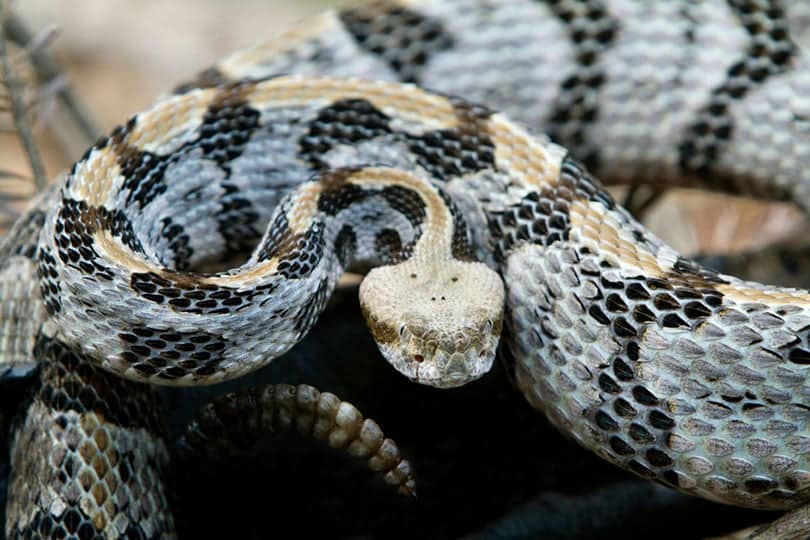There are seven different types of snakes found in Kentucky, each with a distinct design. Snakes live predominantly on small rodents like mice and chipmunks of the area; however, they also eat other reptiles, frogs, birds, and even insects. The most dangerous snake found in Kentucky is the Timber Rattlesnake, usually brown or black with a yellowish stripe along its back.

The 7 Snakes Found in Kentucky
1. Broad-Banded Watersnake
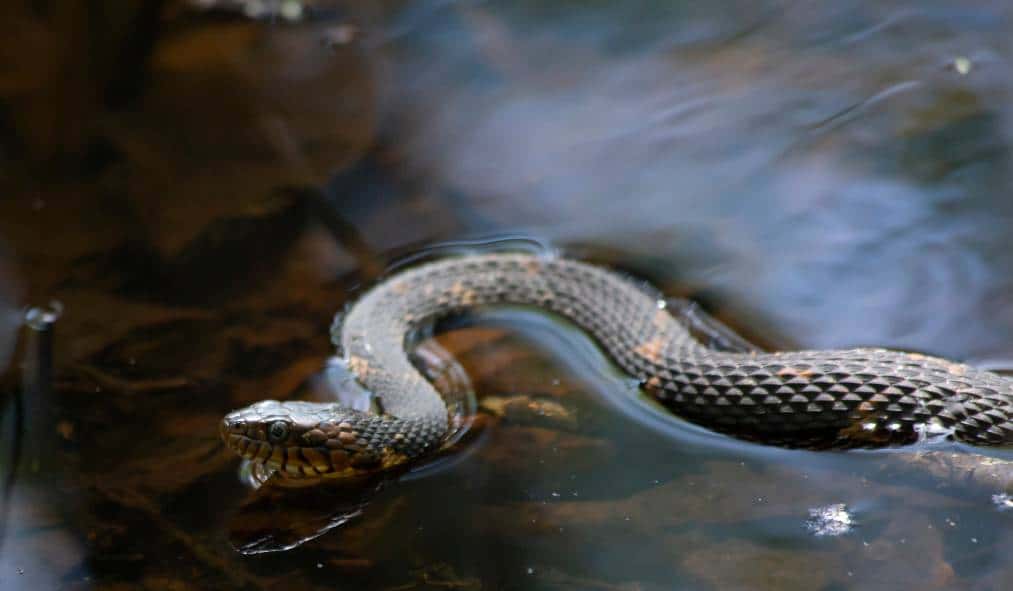
| Species: | Nerodia fasciata |
| Longevity: | Up to 7 or 8 years |
| Good to own as a pet?: | Maybe |
| Legal to own?: | Yes |
| Adult size: | 22-36 inches |
| Diet: | Small aquatic creatures such as fish, tadpoles, frogs, toads, and occasionally crayfish |
The Broad-banded Watersnake is a giant snake, typically reaching lengths of 30 inches. It can sometimes grow to be over four feet long and weigh up to 14 pounds. The coloration on the dorsal side ranges from blueish gray to dark brown with very narrow lighter colored bands that run lengthwise down its body. Some specimens have only faint bands.
There are usually four more golden-colored stripes on the ventral side that run lengthwise down its body, with some models having very narrow dark brown lines running through them. The scales on this snake’s belly will be keeled and rough to touch.
Habitat
The Broad-banded Watersnake is native to the eastern United States. It can be found in forested areas, near the water’s edge, and at higher elevations. They are primarily nocturnal, prefer to hunt for food or shelter during the day but sometimes bask in open terrain on humid summer days.
Appearance
The Broad-banded Watersnake is relatively large and heavy-bodied. It has a gray to brown coloration, with very narrow lighter colored bands that run lengthwise down its body and four golden stripes on the ventral side running from head to tail. Snakes have overlapping scales that are keeled or rough in texture, giving them a coarser feel than other reptiles.
Diet
This snake feeds mainly on frogs and fish, which it locates by sight and smell. Snakes use their tongue to gather information about the environment and allow them to find prey using odor trails as well as vibrations on water from a potential meal swimming below.
2. Gray Ratsnake
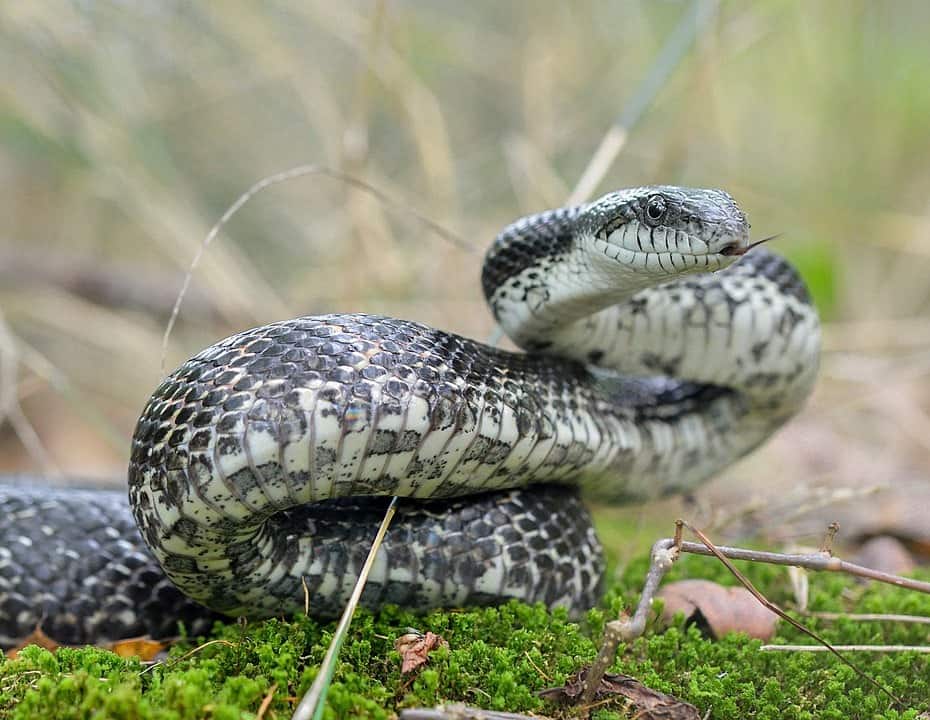
| Species: | Pantherophis slides |
| Longevity: | 10-15 years |
| Good to own as a pet?: | Yes |
| Legal to own?: | Yes |
| Adult size: | 42-72 inches |
| Diet: | Small mammals, birds, and bird eggs |
The gray rat snake is a species native to the Eastern US, and it includes some of the states in this region, like Kentucky. It has been spotted occasionally, but not often around humans or human structures, as they are nocturnal, meaning they hunt for food at night. They have adapted well to live near humans in urbanized areas, too. This species can live in moist, swampy areas with a good supply of water and food.
Habitat
Gray rat snakes are often found in moist, swampy areas with plenty of water and vegetation. They can be found near human structures too, but they prefer to avoid humans as much as possible.
Appearance
This species is black or dark brown on the backside with a cream-colored underside. The belly typically has small red or brown spots on it. They are about nine to eleven inches long and can weigh up to two pounds, with the females being smaller than males.
Diet
Gray rat snakes eat mainly small mammals like rodents, rabbits, and possums which they find by scouring their habitat at night. If there is insufficient prey in a particular area, they will use their natural camouflage to wait for the prey in the bushes.
3. Timber Rattlesnake

| Species: | Crotalus horridus |
| Longevity: | 10-20 years |
| Good to own as a pet?: | No |
| Legal to own?: | Need Permission |
| Adult size: | 2.5-5 feet |
| Diet: | Small- to medium-sized rodents |
The timber rattler is the giant venomous snake found in Kentucky and among the heaviest of native North American snakes. They typically grow to about six feet long and can reach an average weight of 12 pounds. However, they have been known to get over 20 pounds.
The timber rattlesnake prefers to live near the edges of open woods, rocky hillsides, and fields with plenty of ground covers like bushes or weeds. They are nocturnal, so they usually only hunt during the nighttime hours when it is cool enough to function well, but the sunlight is not too bright—snakes found in Kentucky.
Habitat
Timber rattlesnakes live in the eastern part of Kentucky. They prefer to live near woods, rocky hillsides, and fields with plenty of ground covers like bushes or weeds.
Appearance
The Timber Rattlesnake is a giant, heavy snake that ranges from light brown to dark chocolate. The scales along the dorsal side are keeled, which means they have ridges running along their length. Snakes Found in Kentucky
Diet
Snakes found in Kentucky are carnivorous. The timber rattler prefers small mammals that include mice, rats, squirrels, and rabbits as their primary prey, but they will also eat reptiles and amphibians.
4. Eastern Black Kingsnake
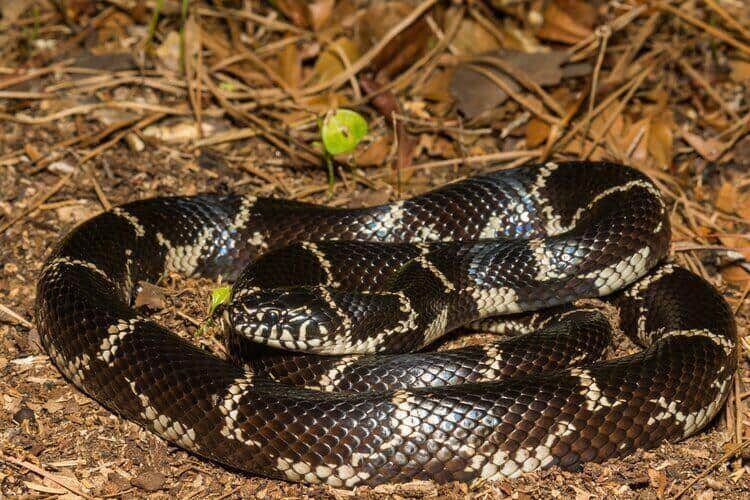
| Species: | Lampropeltis nigra |
| Longevity: | Up to 20 to 30 years in captivity |
| Good to own as a pet?: | Yes |
| Legal to own?: | Yes |
| Adult size: | 36-45 in |
| Diet: | Other snakes, lizards, frogs, rodents, turtle eggs, and birds and their eggs |
Eastern Black Kingsnake is a species of a black snake that can be found in the southern and eastern parts of North America. They are also sometimes called Eastern Corn Snakes because they are often found near corn fields or grain stores, preying on the rats and mice that seek out harvested corn. They are known for their ability to blend into surrounding environments, giving them natural camouflage. However, these snakes pose no threat to humans unless provoked or threatened with violence.
Habitat
Eastern Black Kingsnakes are found in the southern and eastern parts of North America, but not all states.
Appearance
These snakes are black with brown or red-colored stripes. They also have a lighter underbelly and speckles on their face, which they use to camouflage themselves in the environment around them.
Diet
Snakes often eat corn because it is a food source easily located on farms or in crop fields. They also will sometimes consume other small rodents such as mice or rats if they have access to them.
5. Copperhead

| Species: | Agkistrodon contortrix |
| Longevity: | 18 years |
| Good to own as a pet?: | No |
| Legal to own?: | Yes |
| Adult size: | 24 and 36 inches |
| Diet: | Small birds, lizards, small snakes, amphibians, and insects |
The copperhead (Agkistrodon contortrix) is a venomous snake found in the eastern United States. It typically ranges from 12 to 36 inches long and feeds on small mammals, such as mice or rats.
It’s also important to remember two types of these snakes: Northern and Southern Copperheads. The Northern Copperhead is more common and prefers to use trees or bushes as cover. The Southern Copperheads, on the other hand, are far less aggressive but will bite if provoked. The copperhead’s venom is a hemotoxin that can cause tissue damage in its victims.
Habitat
Copperheads are found in deciduous forests, fields, and prairies. They also like to live near water sources such as streams or ponds. Copperhead populations are densest, with a mix of trees, shrubs, rocks, and ground cover for them to hide in. Snakes can spend their entire day at the same place, and they’re good swimmers, so they can find an excellent spot to hide in during the summer months.
Appearance
Copperheads are characterized by a series of alternating dark and light bands that create what looks like an hourglass figure. They also have a triangular head, which is quite different from other snakes in their family. Copperhead skins vary in color depending on the habitat they live in: typically brown to reddish-brown with darker pigment around its eyes and mouth.
Diet
Copperheads mostly eat small mammals such as squirrels, rabbits, and chipmunks. They may also prey on earthworms or frogs if they’re feeling lucky!
6. Dekay’s Brown Snake
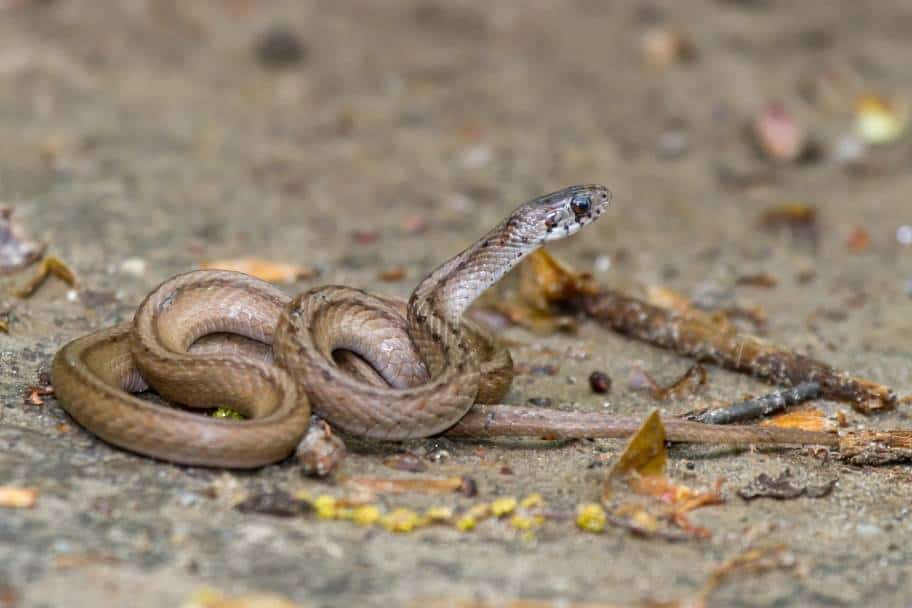
| Species: | Storeria dekayi |
| Longevity: | 7 years old |
| Good to own as a pet?: | Yes |
| Legal to own?: | Yes |
| Adult size: | 9-13 inches |
| Diet: | Earthworms, snails, and slugs |
Dekay’s Brown snake is a snake that was discovered in Kentucky. It has been speculated and debated whether or not the Dekay’s brown snake should be listed as a threatened species because of its decline in population size. One of the reasons for this debate is because other snakes have been found around where they live, such as the northern brown snake. The Dekay’s Brown snake is the only snake found in Kentucky, and it seems to be on its way out due to climate change, habitat destruction, and more.
Habitat
The Dekay’s Brown snake is only found in Kentucky. They like to live in wet areas and are usually seen near water sources such as streams, creeks, or swamps.
Appearance
They are brown, and their back scales have black spots or blotches on them. Snakes can often be mistaken for the Dekay’s brown snake due to their similar looks, but more than one snake species has this color pattern.
Diet
Dekay’s brown snakes eat other small reptiles such as lizards or frogs, along with some invertebrates.
7. Diamond-Backed Watersnake

| Species: | Nerodia rhombifer |
| Longevity: | 9 years |
| Good to own as a pet?: | Yes |
| Legal to own?: | Yes |
| Adult size: | 30-48 inches |
| Diet: | Frogs, toads, slow-moving and small fish |
A Watersnake is a type of snake, and the Diamond-backed Snakes are no exception. This is one of two types of water snakes found in Kentucky, where they can be seen swimming on small tributaries or ponds. They range from three to six feet long, with colors varying from brownish-black with diamond patterns along its back to brown, tan, or beige with dark blotches.
The Diamond-backed Snakes are known for their agility and aquatic lifestyle because they can swim long distances underwater while hunting amphibians, fish, and frogs. The snakes will bite any intruder to protect themselves from being captured by humans or other predators and when feeding on prey that is too large for them to swallow.
Habitat
Snakes found in Kentucky can live on land but prefer a wetter environment.
Appearance
Snakes range from three to six feet long, with colors varying between brownish-black with diamond patterns and the back and light tan or beige with dark blotches.
Diet
Snakes feed primarily on amphibians, fish, and frogs. Their agile nature gives them an advantage when it comes to catching prey underwater. They will eat any animal that is too large for them to swallow.

What is The Most Poisonous Snake in Kentucky?
Timber Rattlesnake is the most poisonous snake in Kentucky.
Are There Poisonous Water Snakes in Kentucky?
Yes, there are poisonous water snakes in Kentucky. The Eastern Cottonmouth is a common snake found in the state with venomous bites that can be fatal if left untreated. Snakes tend to avoid humans and will most likely not attack unless provoked or threatened. If you encounter one of these serpents, back away slowly and make noise to try to scare it away. Snakes can be found in the waterways, along tree lines, near grassy fields, and other places.

Conclusion
Many people find it surprising that Kentucky has more than one poisonous snake. The copperhead and timber rattlesnake can both cause very severe injuries if they strike a human with their venomous bite. It’s essential to identify what kind of snake it is before killing it because pet owners might mistake an Eastern hognose for a cobra or other dangerous species like the coral snake, which has three different colors on its body (red, yellow, and black).
Hopefully, you enjoyed our list of the most common snakes in Kentucky. If we forgot any, let us know!
Learn about the snakes in different regions with one of these related posts:
- 16 Snakes Found in Minnesota (With Pictures)
- 12 Snakes Found in Illinois (With Pictures)
- 11 Snakes Found in Michigan (With Pictures)
Featured Image Credit by Mark_Kostich, Shutterstock
